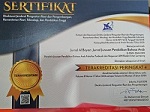Inovasi Pembelajaran Melalui Penelitian dan Pengembangan Bahan Ajar
Abstract
Full Text:
PDFReferences
Borg, W.R, And Gall, M.D. Education Research an Inroduction. London: Longman, Inc. 2007:16
Rogers, Everett M, Diffusion of Inovations. USA, 1995:
Richey dan Klein, Design and development research – methods, strategies and issues. London: Lawrence Erlbaum Associates, Inc., Publishers, 2007
Rita C. Richei and James D. Klein. Development Research Method: Creating Knowledge from Instructional Design and Development Practice. Journal of Computing in Higher Education, Spring 2005;Vol 16 ( tersedia pada http://apling.engl.iastate.edu/tsll/2008/DBRodriguezPardo.pdf
Semiawan, Conny R. Catatan kecil tentang penelitian dan pengembangan ilmu Pengetahuan. Jakarta: kencana. 2007.
Sugioyono. Metode Penelitiian dan R & D, Alpabeta, Bandung. 2008: h. 298.
Udin Saefudin Sa’ud, Inovasi Pendidikan, Bandung, Alfabeta, 2008: h. 8
www.jst.go.jp/crds/pdf/methodology/CRDS-FY2010-XR-25E.pdf
myweb.fsu.edu/jklein/articles/Richey_Klein_2005.pdf
apples.jyu.fi/ArticleFile/download/262
www.professorjackrichards.com/wp-content/uploads/materials-development-making-connection.pdf
www.tojet.net/articles/v11i2/11211.pdfS
research-publishing.net/publication/978-1-908416-00-1.pdf
downloads.slo.nl/Documenten/educational-design-research-part-a.pdf
dspace.ou.nl/bitstream/1820/4992/1/Reeves%26McKenneyTypeset.
ies.ed.gov/pdf/CommonGuidelines.p
http://apling.engl.iastate.edu/tsll/2008/DBR Rodriguez Pardo.pdf
www.arbor.edu/wp-content/uploads/2012/12/ESL326.pdf
web.stanford.edu/~hakuta/Courses/Ed205X%20Website/Resources/Ellis%20Instructed-second-language%20(2).pdf
DOI: http://dx.doi.org/10.24042/albayan.v8i1.356
Refbacks
- There are currently no refbacks.
Copyright (c) 2016 Erlina Erlina
Editorial Office:
Jurnal Al Bayan: Jurnal Jurusan Pendidikan Bahasa Arab, Arabic Education Study Program, Faculty of Education and Teachers Training, Unversitas Islam Negeri Raden Intan Lampung
Jl. Endro Suratmin 1 Sukarame, Bandar Lampung 35131-Indonesia
e-mail: jurnalalbayan@radenintan.ac.id
http://ejournal.radenintan.ac.id/index.php/albayan/index
Jurnal Al Bayan: Jurnal Jurusan Pendidikan Bahasa Arab is licensed under a Creative Commons Attribution-ShareAlike 4.0 International License. p-ISSN 2086-9282 | e-ISSN 2549-1229









